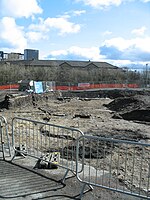Hamilton Crescent

Hamilton Crescent is a cricket ground in the Partick area of Glasgow, Scotland, which is the home of the West of Scotland Cricket Club. Hamilton Crescent hosted the first international football match, between Scotland and England, played on 30 November 1872, which ended in a goalless draw, and was watched by a crowd of 4,000. A plaque on the wall of the clubhouse was placed to commemorate the match in 2002 by Mr John C McGinn, President of the Scottish Football Association.Further international matches were held here in 1874 and 1876, before being moved to the first Hampden Park. The 1877 Scottish Cup Final was also held at Hamilton Crescent, as was a rugby union international when Scotland and Wales drew their match in the 1885 Home Nations Championship.The gates are typically closed to visitors.
Excerpt from the Wikipedia article Hamilton Crescent (License: CC BY-SA 3.0, Authors, Images).Hamilton Crescent
Fortrose Street, Glasgow Partick
Geographical coordinates (GPS) Address Nearby Places Show on map
Geographical coordinates (GPS)
| Latitude | Longitude |
|---|---|
| N 55.8725 ° | E -4.3088888888889 ° |
Address
Fortrose Street
Fortrose Street
G11 5LP Glasgow, Partick
Scotland, United Kingdom
Open on Google Maps








